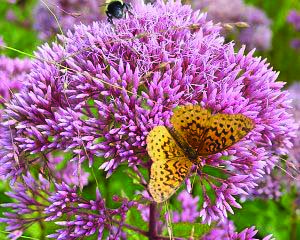As part of the downtown beautification project, a “living fence” is being created of native plants, flowering vines, and deciduous shrubbery, all hardy, adaptable, drought-tolerant plants that will interlace throughout the chain link fence abutting the Ashland Farmers Market area near Montenegro Square. This fence will create a living wall of color and beauty and, ultimately, serve as a natural habitat for butterflies, bees, and other pollinators.
Heading the project is Ashland resident and ecological landscape designer, Cathy Rooney, owner of Designer of Greens. Rooney was responsible for coordinating the purchase and recent plantings of native and historic shrubs, grasses and perennials now punctuating The Corner Spot’s café seating area.
The plant palette will be somewhat like the one used for The Corner Spot, but the living fence will incorporate more shade-tolerant plants species which will bury their roots deep in the soil to get moisture and nutrients. Plantings at The Corner Spot, on the other hand, are in full sun and benefit from an underground irrigation system which waters the foliage during early-morning hours.
“We’re in New England, so plants for the living fence also have to be hardy ones, such as Echinacea purpurea ‘Magnus’, an herbaceous perennial commonly called purple coneflower, a species of Milkweed known as Asclepias tuberosa, Daylily, Aronia or Chokeberry, flowering vines and other plants that will tolerate partial shade as well as survive the cold winter months,” Rooney said. “Many of the plants will attract hummingbirds, butterflies and other natural pollinators.”
Rooney practices four-season gardening with all her clients, and this project will be no different. “The living fence will be designed to have flowers that blossom in early spring and continue with plant specimens that flower well into late fall,” she added.
Rooney is working now with Ashland’s DPW staff to finalize the watering options at Montenegro Square. “Typically, you need to irrigate for three weeks to establish plants. Then, if they are drought-tolerant plants, you don’t want to give them a lot of water. You’ll want the plants to be dependent on Mother Nature.”
The concept of the living fence was initially brought forth at one of the Downtown Summit meetings held in late 2015. It is hoped this project will be yet another means of furthering the attractiveness of the downtown area to new businesses and making the area more visually inviting to area residents and visitors.
“We’ll need volunteers experienced in gardening for the bulk of the planting work,” Rooney added, “but there’s always room for the person who has only one or two hours to offer in some additional way.”
Keep your eye on the Town’s Facebook page for upcoming announcements about volunteers needed for the living fence project and specific planting dates.
Project Begins to Take Life, Making Ashland More Attractive

Issue Date:
August, 2017
Article Body:
